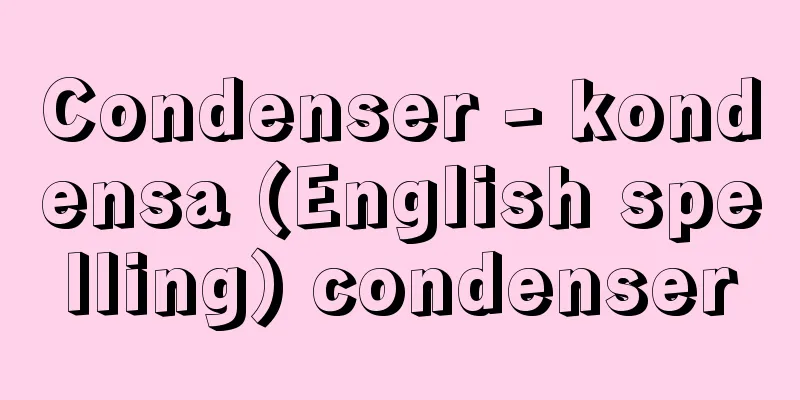Condenser - kondensa (English spelling) condenser

|
A circuit component designed to store as much charge as possible in a certain volume. It is also called a capacitor. The basic structure is a dielectric sandwiched between electrodes, with electrode lead terminals attached, and the whole is housed in a suitable case or molded from resin. The value that indicates how well a capacitor can store charge is called its capacitance. The unit of capacitance is the farad, and the value that stores 1 coulomb of electricity when a voltage of 1 volt is applied is called 1 farad. However, since this unit is too large to express the capacitance of an actual capacitor, units of this value of 10 -6 and 10 -12 are called microfarad and picofarad, respectively, and are widely used in practice. The capacitance of a capacitor is proportional to the electrode area and the relative dielectric constant of the dielectric inserted between the electrodes, and inversely proportional to the distance between the electrodes. Therefore, in order to increase the electrostatic capacitance per unit volume, methods such as selecting a material with a high dielectric constant, using a thinner dielectric, and increasing the area of the electrodes through structural innovations (wrapped structure, laminated structure, uneven electrode surfaces, etc.) are used. When a DC voltage is applied to a capacitor, a charge proportional to the polarity of the applied voltage and the capacitance is stored almost instantaneously in each electrode, and is supplied as a current from the power source. Therefore, a transient current flows in the circuit, but no steady current flows. On the other hand, when an AC voltage is applied to a capacitor, the instantaneous charging phenomenon that occurs when DC is applied changes in accordance with the change in polarity of the electrodes, so that current constantly flows into the electrodes of the capacitor, and the amount of charge flowing in and out of the electrodes per unit time increases proportionally with the capacitance and the speed of polarity change, i.e., the frequency. The AC current that flows at this time is the sum of a component that is in phase with the applied voltage and a component that is 90 degrees ahead of it, and the resultant vector lags 90 degrees by δ (delta). This δ is called the loss angle, and the magnitude of the dielectric loss is expressed as the tangent of the loss angle (tan tan δ). This is called the dielectric loss angle, and for capacitors with small dielectric loss, the reciprocal of the dielectric loss angle, Q , is sometimes used. Capacitors developed and put to practical use as electrical and electronic equipment components use various dielectric materials, and their structure is usually designed to take advantage of the characteristics of the materials used. From the viewpoint of structure, they can be broadly classified into five types: wound capacitors, which are made by overlapping and rolling up a strip-shaped dielectric and electrode foils, such as paper capacitors; single-plate capacitors, which have silver electrodes on both sides of a circular (or cylindrical or rectangular) ceramic dielectric; laminated capacitors, which are made by stacking dielectrics and electrodes alternately, such as mica capacitors; electrolytic capacitors, which chemically generate a dielectric film to increase the capacity per unit volume; and electric double-layer capacitors, which utilize a physical phenomenon called the electric double layer (discovered by German physicist and physiologist Helmholtz in 1879) to significantly increase the storage efficiency. In addition, there are variable capacitors with a variable capacitance structure. These are designed to artificially change the capacitance continuously over a certain range. Generally, the capacitance is changed by changing the opposing area or distance of the electrodes using a rotating or piston mechanism. In addition, condensers found in distillation columns and steam kettles used in the chemical industry, as well as focusing lenses used in projectors, photo enlargers, and microscope lighting devices to focus light onto a small spot, are also called condensers. [Koichiro Sakata] "Electronics Materials" by Toshikichi Josaka and Shigeru Hayakawa (1975, Denki Shoin)" ▽ "Capacitors" by Kohei Kinugawa (1977, Nikkan Kogyo Shimbun)" ▽ "Ceramic Dielectric Engineering - A Supplement to Ferroelectric Physics Exercises" 4th Edition by Kiyoshi Okazaki (1992, Gakukensha)" ▽ "The Right Place for Resistors and Capacitors" by Kazushi Miyake (2000, CQ Publishing)" ▽ "Fundamentals and Applications of Ceramic Capacitors - Supporting the Electronics Industry" edited by Murata Manufacturing (2003, Ohmsha) [References] | | | | | | | |©Shogakukan "> Multilayer capacitors and wound capacitors… ©Shogakukan "> Capacitance of various capacitors ©Shogakukan "> Variable capacitor structure, types and characteristics ©Shogakukan "> The structure of a paper capacitor ©Takashi Aoki Structure of an electrolytic capacitor Source: Shogakukan Encyclopedia Nipponica About Encyclopedia Nipponica Information | Legend |
|
一定の容積にできるだけ多くの電荷を蓄えられるように設計された回路部品。蓄電器、キャパシターcapacitorなどともいう。基本的な構造は誘電体とこれを挟む電極からなり、これに電極引出し端子をつけ、全体を適当なケースに収納あるいは樹脂成形してある。電荷をどの程度によく蓄積できるかを示す値を、そのコンデンサーのキャパシタンス(静電容量)という。静電容量の単位はファラドで表され、1ボルトの電圧を印加したとき、そのコンデンサーに蓄えられる電気量が1クーロンになる値をとって、これを1ファラドとよんでいる。しかし実際のコンデンサーの静電容量を表すには単位が大きすぎるので、この値の10-6、10-12の大きさの単位がそれぞれマイクロファラド、ピコファラドとよばれて、実用上多く用いられている。コンデンサーの静電容量は、電極面積および電極間に挿入した誘電体の比誘電率に比例し、電極間距離に反比例する。したがって、単位体積当りの静電容量を大きくするために、比誘電率の大きい材料の選択、より薄い誘電体の使用、構造面でのくふう(巻込み構造、積層構造、電極表面の凹凸化など)による電極の大面積化などの方法が用いられる。 コンデンサーに直流電圧を印加する(加える)と、それぞれの電極には、印加電圧の極性にしたがい、かつその電圧と静電容量に比例した電荷がほぼ瞬間的に蓄えられ、電源からの電流として供給される。したがって、回路には過渡的な電流は流れるが、定常的な電流は流れない。一方、交流電圧をコンデンサーに印加した場合には、直流印加の際に生ずる瞬間的な充電現象が、その電極の極性変化に追随して変化するため、コンデンサーの電極には絶えず電流が流れ込むことになり、単位時間に電極に出入する電荷量は、静電容量が大きいほど、また極性の転換の速さ、すなわち周波数が高いほど比例的に多くなる。このとき流れる交流電流は、印加電圧の位相と同じ成分と90度進んだ成分との和となり、合成ベクトルは90度よりδ(デルタ)だけ遅れる。このδを損失角とよび、誘電損の大きさを損失角の正切(正接tanδ)で表す。これを誘電正切とよび、誘電損の小さいコンデンサーでは、誘電正切の逆数であるQを用いる場合もある。 電気・電子機器用部品として開発され、実用に供されているコンデンサーでは、各種の誘電体材料が用いられ、構造も普通、使用材料の特徴を生かすようにつくられている。構造面から大別すると、紙コンデンサーのように帯状の誘電体と電極箔(はく)を重ね合わせて巻き込んだ巻込み型コンデンサー、円板(または円筒、角板)状磁器質誘電体の両面に銀電極をつけた単板型コンデンサー、マイカコンデンサーのように誘電体と電極とを交互に積み重ねた積層型コンデンサー、誘電体膜を化学的に生成し、単位体積当りの容量を大きくした電解コンデンサー、電気二重層という物理現象(1879年にドイツの物理学者、生理学者のヘルムホルツが発見)を利用することで蓄電効率が著しく高められた電気二重層コンデンサーなどの5種類に分類される。このほか、可変容量構造をもつ可変コンデンサーがある。これは、ある範囲にわたって人為的に静電容量を連続的に変えられるようにしてある。一般に回転またはピストン機構によって、電極の対向面積ないしは距離を変えて容量変化を行っている。 なお、化学工業分野で用いられる蒸留塔、蒸気釜(がま)などについている凝縮器や、映写機、写真引伸し器、顕微鏡の照明装置などに組み込んで光を小さい部分に収束する集光レンズなどもコンデンサーとよばれている。 [坂田好一郎] 『城阪俊吉・早川茂著『エレクトロニクス材料』(1975・電気書院)』▽『衣川浩平著『コンデンサ』(1977・日刊工業新聞社)』▽『岡崎清著『セラミック誘電体工学――強誘電体物理学演習補足』第4版(1992・学献社)』▽『三宅和司著『抵抗&コンデンサの適材適所』(2000・CQ出版)』▽『村田製作所編『セラミックコンデンサの基礎と応用――エレクトロニクス産業を支える』(2003・オーム社)』 [参照項目] | | | | | | | |©Shogakukan"> 積層型コンデンサーと巻込み型コンデンサ… ©Shogakukan"> 各種コンデンサーの静電容量 ©Shogakukan"> 可変コンデンサーの構造と種類・特性 ©Shogakukan"> 紙コンデンサーの構造 ©青木 隆"> 電解コンデンサーの構造 出典 小学館 日本大百科全書(ニッポニカ)日本大百科全書(ニッポニカ)について 情報 | 凡例 |
Recommend
Western Wall Incident - The Western Wall Incident
A clash between Jews and Muslims that occurred in ...
Picture-writing song - Ekakiuta
This is a song sung as part of children's play...
Habitat (English spelling)
The place where an individual or population of org...
Atreus - Atreus (English spelling)
A hero in Greek mythology. Son of Pelops and Hipp...
Kyrillos (of Jerusalem)
315 koro-386 Bishop of Jerusalem who was instrumen...
Brick - Brick (English spelling)
A type of building material made primarily from cl...
Panthera tigris corbetti (English spelling) Pantheratigriscorbetti
…[Maki Sachiko]. . . *Some of the terminology tha...
Image orthicon - Image orthicon (English spelling)
A type of television camera tube developed by RCA...
Top quality fishing - Uwamonozuri
...The fish anglers call "stonefish" an...
Left Minister Kawara
Another name for "Minamoto no Tooru (Minamoto...
Coastal open area - Engankaihochiiki
... After that, the number of designated areas on...
Caesar
…For example, there are Greek basileus, basileōn,...
Zagazig
The transportation center of the Nile Delta in nor...
Valve passage - Bendou
Written by Ogyu Sorai. 1 volume. Completed in 1717...
Daijizaiten - Daijizaiten
A Buddhist deity. Maheshvara is a translation of ...









